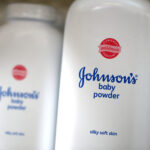Health advocates and Rhode Island officials say it will be much harder to eliminate childhood lead poisoning after the state Supreme Court overturned a landmark jury verdict that could have led to a multibillion-dollar cleanup of lead paint.
The court’s decision scraps the state’s proposed $2.4 billion cleanup of contaminated homes that was to have been bankrolled by three former lead paint companies — including Cleveland-based Sherwin-Williams Co. — found responsible for creating a public nuisance.
Officials say the ruling means they’ll have to rely on a more piecemeal approach to fighting lead poisoning than the sweeping fix they hoped the cleanup would provide.
“The lead suit could have been used to make those places safe for kids, so that we never have to worry about it anymore,” said Dr. Robert Vanderslice, who deals with lead paint problems for the state Department of Health.
“Instead, we’re going to have to use the strategies we’ve been using to decrease lead poisoning,” he added. “We’re going to have to reinvigorate some of those efforts.”
The state’s proposal would have required Sherwin-Williams, NL Industries Inc. and Millennium Holdings LLC to pay to remove or permanently enclose lead paint from roughly 240,000 homes built before 1980, two years after lead paint was banned from residential use in the United States.
The companies argued at trial that the state already has the tools it needs to end childhood lead poisoning, such as sanctions against landlords who don’t maintain residential property.
Advocates and state officials said the broader cleanup, which they estimated would take four years and involve 10,000 workers, would have allowed them to forever prevent lead poisoning rather than responding after it occurs. They said the problem was especially urgent in Rhode Island, which has a large stock of older homes.
But that cleanup was contingent on the Supreme Court’s approval of a first-ever jury verdict against former lead paint companies. The court overturned the verdict Tuesday, ruling that the three companies did not have control of their product after they sold it.
“You’d hear conversations here and there — people were looking forward to there being resources available,” said Roberta Hazen Aaronson, executive director of the Childhood Lead Action Project, a local advocacy group.
With the cleanup off the table, attention is turning to the state’s more modest resources.
Those include a commitment from Dupont Co. to pay for the cleanup of 600 contaminated homes. Dupont promised the work, and also agreed to pay millions of dollars, in exchange for being dismissed from the lead paint lawsuit in 2005.
The state has so far distributed $1.2 million of the Dupont money to a half-dozen community groups for education, outreach and training.
The cleanup work could start later this summer once properties are selected from the state’s bigger cities, where poisoning is most prevalent, said John Palangio, chief of staff to Attorney General Patrick Lynch.
Other tools include state laws requiring landlords to maintain their properties, with sanctions such as fines for those who do not. Landlords at older properties are required to do visual inspections, take an awareness class and obtain a conformance certificate. Homeowners who meet income requirements are eligible for loans to renovate their properties.
The paint companies say the state would be better served by targeting delinquent landlords who allow lead paint at their properties to chip and flake, exposing child tenants to poisoning.
Michael Nilan, an attorney for Millennium Holdings, said the state knows exactly who those landlords are, but at least at the time of trial, it had taken only a small fraction to court. The attorney general’s office says it relies on the health department to bring negligent landlords to its attention.
Nilan said the laws were already working, as the incidence rate of childhood lead poisoning has declined from 6.6 percent in 1998 to 1.3 percent in 2007, according to the health department.
“We felt and said at the time that it was such a misalignment of resources that the attorney general has,” he said.
Vanderslice, the healthy homes and environmental team leader for the health department, said punishing landlords doesn’t do any good if there’s no money to pay for cleanup and repairs. He also said lead paint becomes less of a priority in neighborhoods where residents are already dealing with foreclosures and multiple maintenance problems.
It typically costs thousands of dollars to properly clean just an individual home of lead paint.
“When you can’t make your mortgage payments, the fact that the paint is peeling off your home is not the same degree a crisis as it is when you’ve got plenty of money for maintenance and to pay your mortgage,” he said.
Was this article valuable?
Here are more articles you may enjoy.

 Harvard Study Again Stirs the Pot on Demotech Ratings of Florida Carriers
Harvard Study Again Stirs the Pot on Demotech Ratings of Florida Carriers  J&J, Kenvue Told to Pay $45 Million to Baby Powder User’s Family
J&J, Kenvue Told to Pay $45 Million to Baby Powder User’s Family  Report: Claims Handlers Embracing Technology
Report: Claims Handlers Embracing Technology  California Sees Two More Property Insurers Withdraw From Market
California Sees Two More Property Insurers Withdraw From Market 